Imagine an angel of the Apocalypse: a gray-caped cross-dressing Vodou warrior saint and flasher; his head a grotesquely grinning human skull topped by a white military helmet and set off by a rusty metal nimbus and a big pink bow; his metal phallus erect and “spring-loaded” for instant action; his arms opened wide as if in greeting, yet at the same time wielding a “sword” and “shield” obviously purloined from the local junkyard.
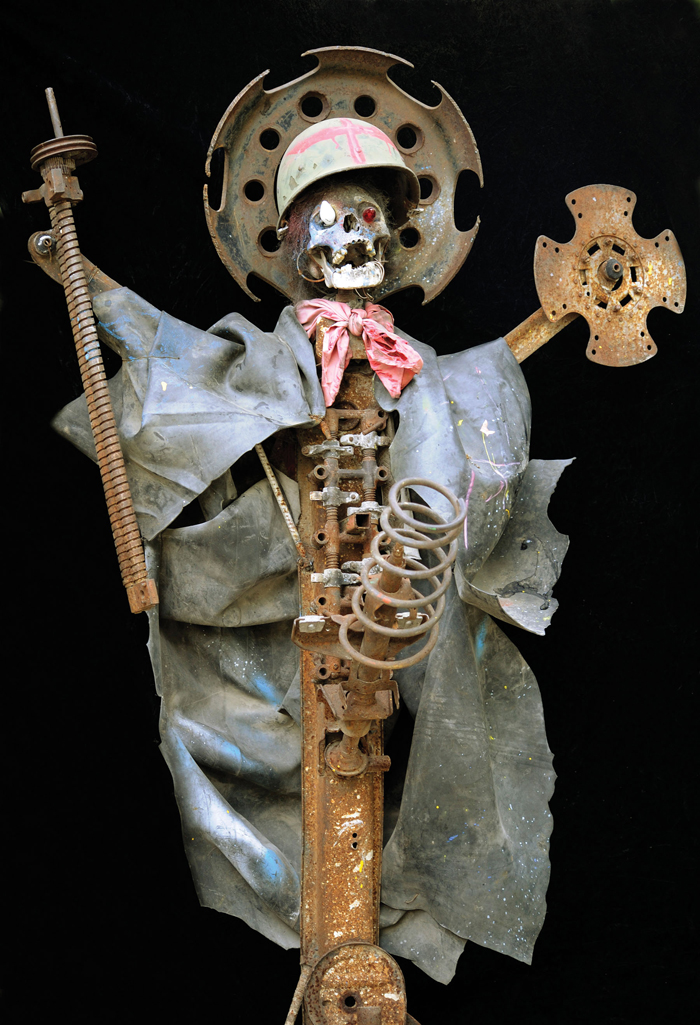
André Eugène, Military Glory, 2010. Mixed media, height: 72 inches. Collection of the artist. Photo: Leah Gordon.
This bizarre and enigmatic angel, incongruously dubbed Military Glory, was devised and constructed in 2010 by the Haitian artist André Eugène, one of the so-called Atis Rezistans (Resistance Artists)1 or Artists of the Grand Rue, working in a warren of living spaces, ateliers, junk shops, and businesses based on the recycled economics of cast-off Western disaster relief,2 all spread out in a district near the heart of Haiti’s capital Port-au-Prince. Even prior to the cataclysmic earthquake of January 12, 2010, the alleyways, courtyards, covered passages, and shacks of the Grand Rue looked like the set from a Bladerunner-esque sciencefiction thriller set in the urban nightmare of some dystopic future.3
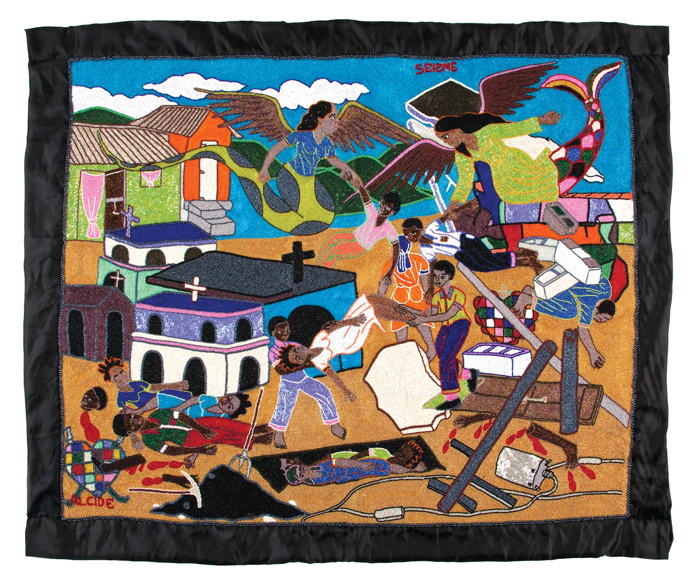
Evelyne Alcide, Séisme (Earthquake), 2010. Beads, thread, polyester; 41 x 50 inches. Fowler Museum at UCLA, x2010.17.4, museum purchase, the Jerome L. Joss endowment fund.
Within that environment, Eugène’s Military Glory must have appeared as one visionary apparition among many: some larger, some smaller, but all equally grotesque, equally ad hoc, and equally enmeshed in the articulation of their own bizarre environment.4 Standing alone in the Fowler Museum’s extraordinary show In Extremis: Death and Life in 21st-Century Haitian Art, the work functions as an emblem or a synecdoche, condensing within itself all the aesthetic, ideological, and religious energy of the exhibition, and of the art of contemporary Haitian Vodou. It also serves as a reminder of that art’s interpretive and contextual complexity, and (at least inferentially) of the similar complexity of other post-colonial manifestations of the sacred within a world of globalized post-modernity.5
If this sounds like a lot to ask of a single work, it is; but perhaps it is only to be expected given the density of the historical strata, the protean extravagance of religious ideology, and the contradictory richness of the aesthetic traditions and patterns of cultural appropriation within which the works displayed in the exhibition are situated. Indeed, that situation itself is further complicated by an implicit tension between the historical space of the museum (necessarily de- or re-contextualizing despite the best curatorial efforts) and the space of existence actually in extremis, the lived space of the brutalized island nation where many of these works have functioned not as emblematic or synecdochal “reminders” of interpretive complexity, but rather as channels of spiritual power and embodiments of spiritual presence.
According to the usual interpretive protocols governing Western art history, we would refer to a figure identified as representing “Military Glory” as allegorical or as an embodied concept. And indeed, Eugène’s warrior-saint may very well have such a metaphorical resonance, although clearly it seems intended to be read ironically, against the glorious grain of its title. Haiti has had numerous experiences with military occupation and oppression both domestic and foreign,6 although at the time Eugène was working on Military Glory, Haiti’s own army had been impotently (pun intended) and unceremoniously disbanded.7
But the art associated with Haitian Vodou does not operate in this kind of abstract way; rather, it tends to function more concretely: this art figures “beings” rather than “ideas” or “concepts.” In the past, such an approach might have been labeled simply “primitive” and the artifacts deriving from cultures prone to function in this concrete way consigned to museums devoted to anthropology or ethnography rather than fine art. This is not the place to rehearse the complicated and violent contest that has enveloped these strategies and ideologies of collection, taxonomy, analysis and display. However, I do think that two specific points need to be made.
First: the Fowler Museum at UCLA, which mounted the exhibition In Extremis, is among the most vibrant and engaged venues in Los Angeles for the display of the vast array of cultural production associated with the world art(s) and cultures whose academic study is the purview of the UCLA Department of World Arts and Cultures/Dance.8 Second, the art on display in the exhibition can only be considered “primitive” when viewed from the kind of racist, colonialist perspective that is by now (I hope) totally discredited. The sophistication and complexity of the meanings with which the Haitian artists have endowed their work with dense overlays of concrete identifications and associations can be dazzling. This strategy is perhaps most evident in contexts that are explicitly religious. But even in the case of Military Glory it is easy to see how the figure’s satirical meaning is established and enriched through oppositions of this sort: of the white helmet and the pink bow; of the skull and the phallus; of the nimbus of sanctity and the weapons of war (an opposition not unfamiliar within Christian theology and iconography).
Furthermore, as a religious image, we can see Eugène’s figure articulating at least two such oppositions. First, as our so-called “angel of the Apocalypse,” he is both the grinning and unremitting angel of death and the archangel Saint Michael who finally defeats the dragon, which is the devil.9 In both these guises, and through a complicated series of changes that incorporates further shifts in a marvelously labile identity, he becomes also a figure of Gede. Gede is a Vodou spirit whose origin can be located “at the heart of a mythopoeic matrix that has its genesis in West Africa” but who has become ubiquitous, especially in Haiti’s urban centers where, among other things, he personifies the pèp ayisyan (the Haitian people itself) in all their contradictory complexity.10 And it is as the spirit Gede that he channels the power of life through the erect and decidedly un-angelic phallus, and thus challenges the apocalyptic power of death, converting death’s skeletal grin into a leer of lustful and rampant desire.11
Technologies of the Sacred
This sounds complicated, and it is. But the underlying structure is relatively simple. Although it has often been caricatured as a dangerously primitive manifestation of transmogrified African myths and magical practices, there is little question but that Vodou is a legitimate religion or, since “religion” is an obviously loaded term in this context,12 what we can call a technology of the sacred. As such, it is a child of the horrendous Middle Passage and the unrelentingly brutal and dehumanizing exigencies of the Caribbean slave economy. It has important roots in indigenous West African cultures, for example those of the Guinea Coast and Kongo.13 Its development on the western end of the Caribbean island of Hispaniola corresponds in large measure to the pre-modern growth of the sugar economy in the eighteenth century following the cession of what was to become Haiti from Spain to France in 1697. As the eighteenth century progressed, the creolizing slave population developed its own cultural and religious practices (including Vodou) in coerced association with and in resistance to both a Francophone colonial administration and the religious institutions of French Catholicism. Despite a roughly sixty-year hiatus from any significant institutional French or Catholic presence following the successful revolution of 1791–1804,14 the imprint of that association and that resistance on the iconography, the liturgical practice, indeed on the entire belief system of Haitian Vodou remains both obvious and occult (that is, hidden “in plain sight” while in turn hiding transformed, inverted, or subverted meanings).

Pierrot Barra, Cross with Spoon and Fork, 1995. Wood, fabric, metal, plastic appliqué; height: 49 inches. Fowler Museum at UCLA, x94.76.10; Museum Purchase, Manus Funds.
To take a relatively straightforward example: Pierrot Barra’s exquisite and superficially whimsical construction Cross with Spoon and Fork (1995). At first glance, it might resemble the ultimate in girlish “tweener” craft construction, with all the smiling dolls, sequins, bows, lace, ribbons, etc. But the actual meaning is quite different, and quite menacing. The dismembered, disarticulated dolls in fact represent the fragmentary remains of a feast (consumed with the marvelously decorated fork and spoon) provided for the lwa15 Bawon Kriminel who feasts (in a sweet inversion of name and function) on those who defy his justice. The central cross is thus not the cross of Christian redemption, despite the presence of the tiny crucifix hung with the body of the divine Redeemer, but rather the kafou crossroads associated with choice and judgment16—the crossroads, perhaps, at which Robert Johnson met the Bawon in a different guise, and made his own fateful and fatal choice. In any case, the artist’s work here is meant, literally, to serve as a repository for all the “mojo” (good luck) required to preserve the owner from a particularly nasty culinary fate: being “taken to meet the Bawon, [who’ll] turn you into a pig. He’ll use the fork and spoon to eat the meat, without a knife.”17
At its heart, Vodou, like Christianity (as well as many indigenous African religions), is essentially a monotheistic religion. That unitary God, however, is a rather distant and unconcerned if basically benevolent creator (and rather “Newtonian” in that regard).
It is the lesser spiritual beings or lwa who are charged with the mediation for human beings of the world of the flesh and the world of the spirit. These beings, who are neither precisely gods nor precisely angels, comprise a rich and varied panoply, and their activities infiltrate every aspect of the believer’s life, including even the interiority of that believer’s very being.18
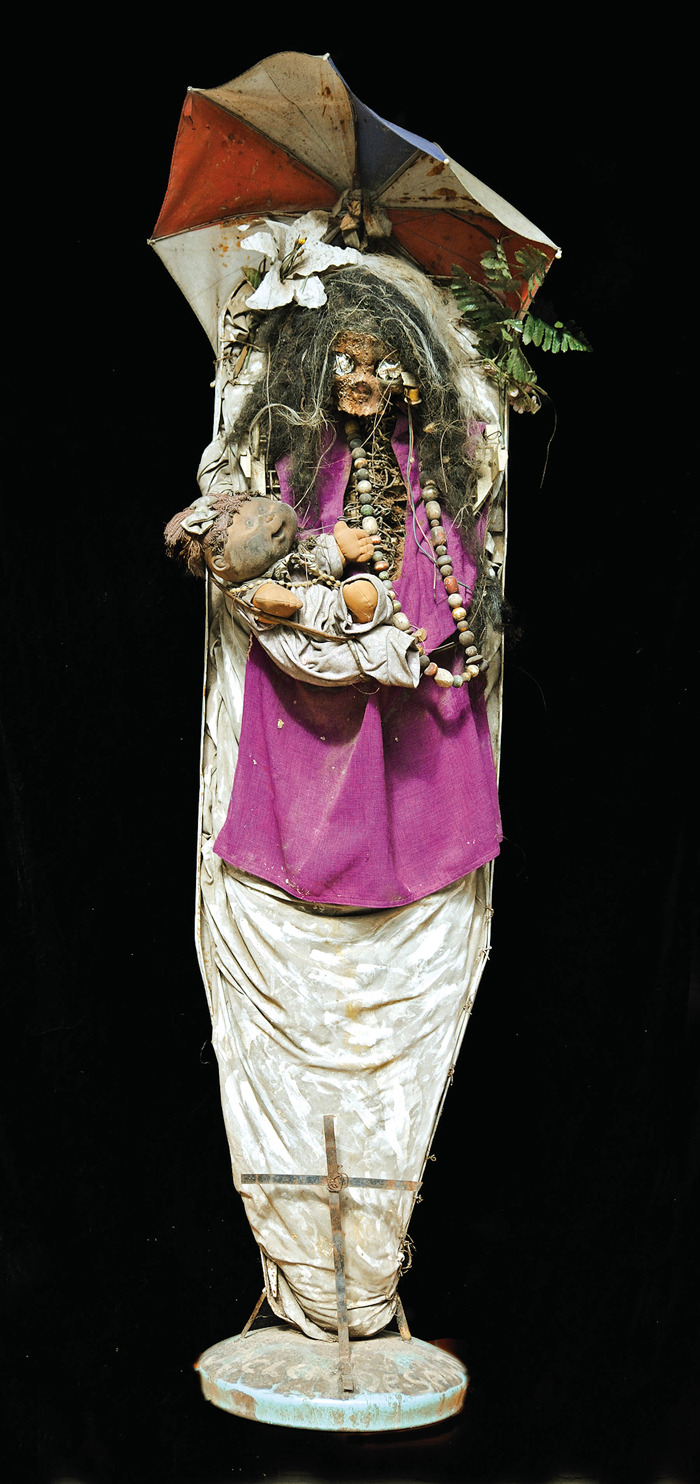
Jean Claude Saintilus, Grann Brijit, 2009. Mixed media, no dimensions given. Collection of the artist. directness. Photo: Leah Gordon.
Within the expansive “pantheon” of the lwa, pride of place has traditionally been given to Ogou, the revolutionary leader and [spiritual] founder of the Black Republic (frequently identified with Saint Jacques) and his heavenly consort, Ezili Dantò, doppelgänger of the Virgin Mary.19 It is the contention of the organizers of In Extremis, however, that over the last ten or fifteen years, a previously rather marginalized “family” of lwa centered on the Bawon Samdi (Baron Samedi) and “the ex-whore Grann Brijit,” inverted reflection of the virginal Ezili Dantò and Samdi’s “Morticia-like bride,” have assumed an ever-greater importance within the Haitian spiritual universe. This rather ghastly pair is accompanied by Samdi’s “strange brothers, the imbecilic Bawon Lakwa, who keeps the cemetery grounds; the gnomic Bawon Simityè, who knows the secrets of the dead; and the psychotic Bawon Kriminel, biting himself and wounding others,” whose decorative tableware we have already examined. Samdi, especially, appears as a spirit of considerable sexual potency; and so it is not surprising that the Bawons as a group have sired a “limitless band of capricious children, known collectively as the Gedes, who are as beloved of Vodouists as the Bawons are feared,” and who assume a bewildering number of guises, even going so far as to impersonate figures of erstwhile power and potency like André Eugène’s Military Glory.20 Bawon Samdi himself, no doubt in recognition of that potency and acknowledgment of his special position of pre-eminence, is often referred to in his role of paterfamilias, as Papa Gede (or simply as Gede).21 As one might expect, his dress is formal (if occasionally flashy), his behavior not so much, as we can see in a beautiful anonymous flag from the Fowler collection, where the Bawon is dressed in traditional top hat and morning coat, yet kicks up his bare feet in a lively dance.22 Of all the Bawons, it is certainly Samdi/[Papa] Gede who has become the tutelary spirit of contemporary Haitian Vodou.
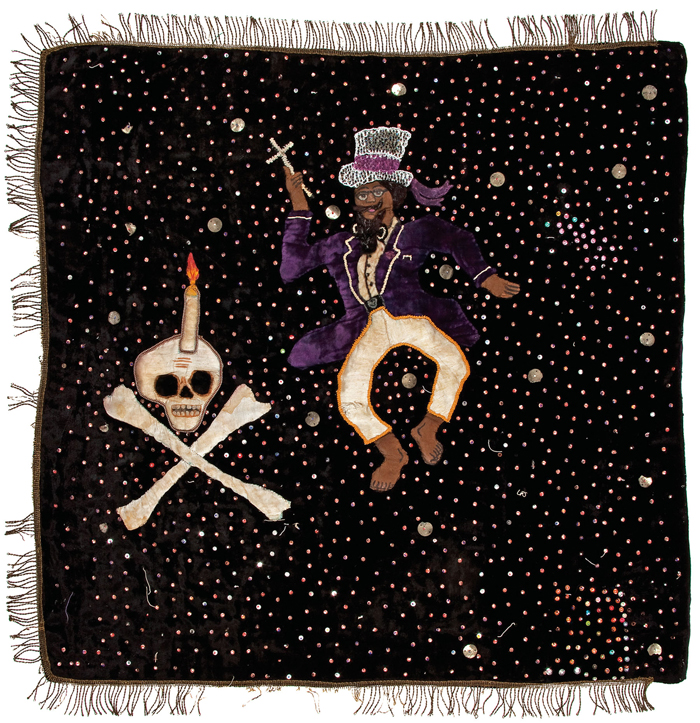
Artist Unknown, Flag with dancing Papa Gede, second half of the twentieth century. Sequins, beds, fabric; 33 × 33.5 inches. Fowler Museum at UCLA, x87.19.
Apocalypse Now
The reasons for this recent shift in Vodou’s spiritual “center of gravity,” as well as the registration of that shift in the visual arts (so carefully documented and illustrated by the organizers of In Extremis) are many: including environmental, economic, political, and cultural factors. And they have their roots deep in the country’s troubled history. Yet for all of that, it is easy to recognize a single event as focusing all those varied causes, all that complicated and tortured history into a single apocalyptically transformative event: the cataclysmic 7.0 Richter earthquake that struck the island nation at 4:53 on the afternoon of January 12, 2010—“a catastrophe beyond even the comprehension of the god of death.”23
And I saw, and behold a pale horse, and its rider’s name was Death, and Hell followed after him; and they were given power over a fourth of the earth, to kill with sword and with famine and with pestilence and by wild bests of the earth. —Revelation 6:8
The word “apocalypse” seems to get tossed around quite a bit these days (as, most frequently and ironically at the moment, in the phrase “zombie apocalypse”) but what happened in Haiti in 2010 was truly apocalyptic in scope. With a death toll of 200,000 to 300,000 and over one million people left homeless and destitute as against an estimated current population of about 9,800,000, it really must have seemed as if a quarter of the Earth had been given over to Death.24
The enormous human and spiritual cost of that quake is graphically captured by Myrlande Constant’s beaded and sequined commemorative mural, which was commissioned by the Fowler Museum. The dead, the injured, and the mourning are everywhere. The Cathedrals of Sainte-Trinité and Our Lady of the Assumption,25 as well as numerous Vodouist shrines, lie in ruins, their priestly attendants among the dead. The devastation is presided over by a Gede Trinity standing at the kafou crossroads: Grann Brijit in her purple dress flanked by the dancing figures of Bawon Samdi and Bawon Kriminel.26

Myrlande Constant, Haiti madi 12 janvye 2010 (Haiti, Tuesday, January 12, 2010), 2012. Fabric, beads,sequins, 94 x 98 inches. Collection of the Artist (commissioned by the Fowler Museum at UCLA with funds provided by the Fay Bettye Green Fund to Commission New Work).
Just below and to the left of Bawon Samdi (almost, it seems, the object of his leering gaze) a woman stands holding a dead child. Within the catalog, although not, alas, in the exhibition, her grief is mirrored and transmogrified by Jean Claude Saintilus’s monstrous Grann Brijit (2009), a rotting, cadaverous hag wearing a white robe or shroud and purple surplice-like vestment, decorated with ferns and white daylilies, protected by a multi-colored umbrella, and carrying as if to present it, a “distressed” doll of the Cabbage Patch variety, also whiteclad and smiling stupidly through the filth and dirt that has stained her face. The thin metal cross that adorns the base gives the whole a hideous quasi- Christian resonance, although I suspect that it reads as acknowledgment rather than indictment, a reconfiguration of the traditional association between the Virgin Mary and the revolutionary Ezili Dantò.
Although Saintilus’s Grann Brijit predates (prefigures) the 2010 earthquake, she still speaks eloquently to the apocalyptic forces made concrete by the quake, located and fixed as a point in historical space and time. Likewise Jean Hérard Celeur’s Sculptural Triptych (2006), with its trio of Gede “Horsemen” or junk-yard cyborgs,27 whose grime encrusted skulls surmount rusted out motorbike frames that function both as bodies and as steeds, for the Gede are “mounted” both on and in the servitors they possess.
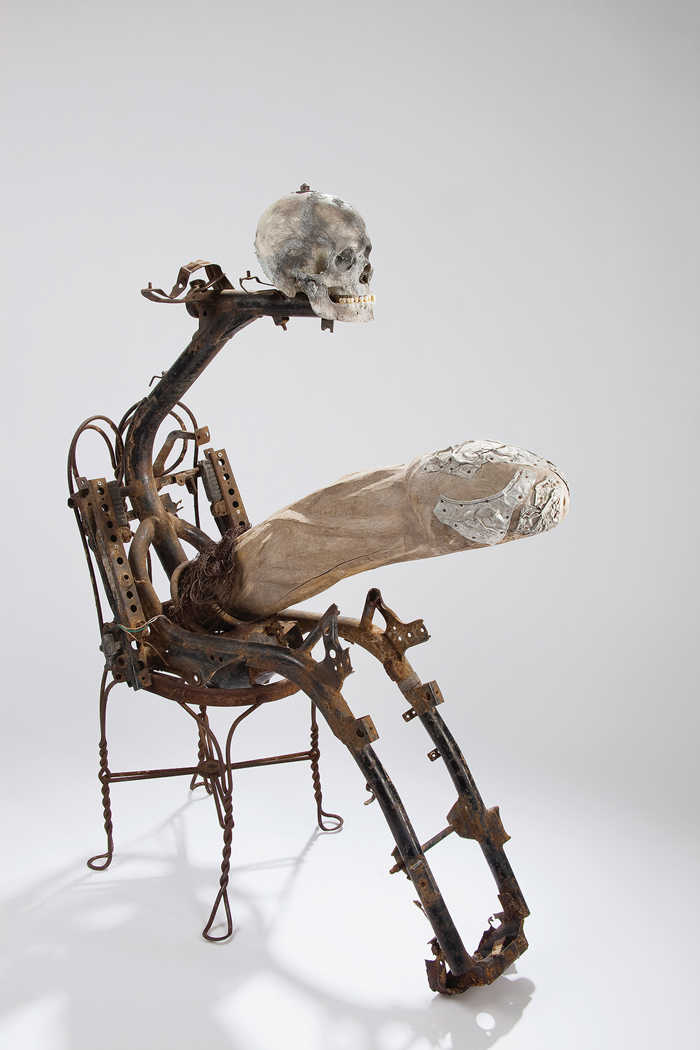
Jean Hérard Celeur, Sculptural triptych (detail), 2006. Metal and mixed media, height: 48 inches. Fowler Museum at UCLA, x2011.24.53; x2011.24.52; x2011.24.54; Gift of Marilyn Houlberg.
All three of the figures sit tense, heads thrust forward, yet also almost gracefully, thanks to the curvature of the tubular framework, on discarded and seat-less chair frames. From the would-be crotch of one rises an enormous erect and engorged phallus protectively tipped by what appear to be thin sheets of cast-off aluminum or tin.28 The struggle here between Eros and Thanatos seems obvious, and in some certainly subliminal way, Freudian as well. For, like so many of the pairs of opposed concepts and identities within the Vodou worldview, the forces of life and death exist simultaneously in uneasy conflict and reconciliation within each individual: here in the balance between an animated death and a damaged or diseased sexuality, immortal adversaries in an eternal struggle. “But who can foresee with what success or what result?”29
Gede in Post-Modernity (Slouching toward Port-au-Prince)30
As has, I hope, become abundantly clear, Vodou is a religion of enormous appropriative power. In its pre-modern history, for example, it was able to absorb beliefs, liturgy, and iconography from a dominant colonial Catholicism, at once affirming and subverting both appearances and meanings, while granting its believers the spiritual and ideological space necessary to live “invisibly” within a population overwhelmingly Catholic by every official measure.
Today, despite a vigorous diaspora, Vodou is still a faith rooted in a ravaged third world country awash in the detritus of globalized post-industrial capitalism. As such, it can support a vision where “Our Lady of Perpetual Help…Vodou’s ‘Black Madonna’ is now perceived in videos of Lady Gaga in black leather torture pants.” At the same time, the revolutionary hero Saint Jacques (aka Ougu) is now identified with, among others, Barack Obama and Sylvester Stallone in the guise of Rambo.31 This almost perverse disruption of categories, this ability to move with ease across space and time, from high culture to low, from indigenous belief to post-colonial consumer ideology is at once definitive of what has always been the structure of Vodou’s emergent belief system; reflective of the common postmodern strategy of uninhibited cultural appropriation, quotation, and citation; and consonant with that technology of the sacred that David Chidester, in a brilliant analysis of sacred technologies in post-apartheid South Africa, has termed “wild religion.”32
For Chidester, a “wild” religion is one that can function simultaneously to disrupt and to integrate a sacralized social order. It is on the one hand “untamed, undomesticated, uncultivated, unrestrained, unruly, and dangerous,” and on the other, “dynamic, natural, extraordinary, enthusiastic, ecstatic and invigorating.”33 It encompasses radical oppositions and, rather than homogenizing, holds them in a dynamic and unstable equilibrium. In the case of Vodou, this essential “wildness” has enabled the production of a scandalously heterogeneous and wonderfully creolized Haitian sacred. In the most expansive case, it might be possible to argue that this vision provides at least one strong alternative for imagining the general structure of any viable religion in post-modernity.
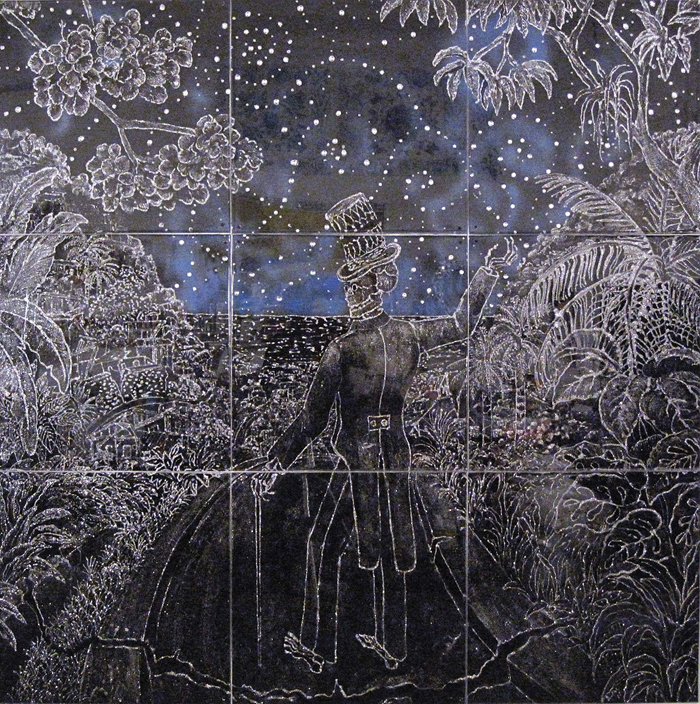
Edouard Duval-Carrié, Le Baron triomphant, 2011. Mixed media on aluminum; nine panels, each panel 28 × 28 inches. Courtesy of the artist. Photo: Jide Shabaka.
In the meantime, we are left with a final post-earthquake image of Edouard Duval-Carrié’s Le Baron triomphant (2011). Samdi stands on an open road in a lush landscape that suggests perhaps his ancestral home: Lavilokan, the mirrorworld of the lwa, the notional Africa at the bottom of the sea34 from which he looks down onto the rubble of a ruined city. Skeletal now and barefoot, yet dressed to the nines, he strides jauntily down the road with a walking stick in his left hand, away from us and toward the city that lies as it were “in the Valley of Death.” His right hand is raised in an ambiguous gesture. Does he bid us “Au revoir,” or, with a more dreadful finality, “Adieu?”35 Or is the gesture perhaps an offer, a suggestion that we follow, down the road, into the black night, toward whatever awaits in the ruins below?
Glenn Harcourt received a PhD in the history of art from the University of California, Berkeley. He currently lives and works in Los Angeles.
